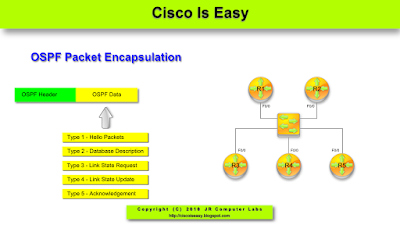Lesson 55 - Introduction to IPv6 - Addresses
Lesson 55 - Introduction to IPv6 - Addresses
Network Address Translation I have rambled about in the last four posts, is designed to deal with a rapid IPv4 address depletion. The scope of 32 bits, allows to allocate 4 294 967 296 unique numbers. Even though, it seemed a lot in late 80s, the exponential growth of the Internet in 90s showed us that 4.3 billion addresses are not enough to uniquely identify our devices these days. The solution to the problem, at least for now, is to use IP version 6.
But what happened to IPv5?
I have found the answer to this question at:
http://compnetworking.about.com/b/2008/11/05/what-happened-to-ipv5.htm
IPv6 Header
IPv6 Header has been simplified in order to improve the efficiency on the routers. Fewer header fields to process, allow faster transmissions. Take a look at the comparison between IPv4 and IPv6 headers:
http://www.cisco.com/en/US/tech/tk872/tech_white_papers_list.html
(IPv6 Headers at Glance.pdf)
IPv6 header does not use checksum, the TTL field has been replaced with Hop Limit name, and packets will no longer be fragmented (Path MTU Discover is going to be performed or the minimum MTU must be used: 1280 bytes).
IPv6 uses 128-bit addresses and offers us quite a number of unique identifiers:
So the number of addresses available is this:
Chances are that we will not run out of these till the end of this century.
In IPv6 designers gave up on broadcast transmissions. They have been replaced with multicast and unicast.
IPv6 Address Notation
Decimal notation has been replaced with hexadecimal using 16 characters (0,1,2,3,4,5,6,7,8,9,a,b,c,d,e,f). A=10, B=11, C=12 etc. You can use both upper and lower cases to address your device since the numbers are case insensitive.
IPv6 address consists of eight groups of four characters (2-byte values) delimited with the colon (:). Take a look at this address:
Addresses still use the hierarchy like we in IPv4. They are divided into two parts. The green one (64 bits) denotes the network portion, and the blue one is a interface identifier. Since it would be tedious to type in all these numbers, we can use few shortcuts.
Leading zeros omitted:
2001:0db8:65a3:0000:0000:5d2e:0370:7134 can be abbreviated to:
2001:db8:65a3:0000:0000:5d2e:370:7134
Groups of four zeros can be abbreviated to a zero:
2001:0db8:65a3:0000:0000:5d2e:0370:7134 can be abbreviated to:
2001:0db8:65a3:0:0:5d2e:0370:7134 can be abbreviated to:
Multiple contiguous groups (2-byte groups) can be abbreviated to double colon (::) but only once
2001:0db8:65a3:0000:0000:5d2e:0370:7134 can be abbreviated to:
2001:0db8:65a3::5d2e:0370:7134
Following all these shortcuts:
2001:0db8:65a3:0000:0000:5d2e:0370:7134 will be represented
2001:db8:65a3::5d2e:370:7134
Types of IPv6 addresses
There are few types of addresses w need to know about. These are:
But what happened to IPv5?
I have found the answer to this question at:
http://compnetworking.about.com/b/2008/11/05/what-happened-to-ipv5.htm
IPv6 Header
IPv6 Header has been simplified in order to improve the efficiency on the routers. Fewer header fields to process, allow faster transmissions. Take a look at the comparison between IPv4 and IPv6 headers:
Pic. 1 - IPv4 Header.
Pic. 2 - IPv6 Header.
Pic. 3 - IPv4 and IPv6 Header Field Comparison.
Source:http://www.cisco.com/en/US/tech/tk872/tech_white_papers_list.html
(IPv6 Headers at Glance.pdf)
IPv6 header does not use checksum, the TTL field has been replaced with Hop Limit name, and packets will no longer be fragmented (Path MTU Discover is going to be performed or the minimum MTU must be used: 1280 bytes).
IPv6 uses 128-bit addresses and offers us quite a number of unique identifiers:
3.4 x 10 ^ 38
So the number of addresses available is this:
340,282,366,920,938,463,463,374,607,431,768,211,456
Chances are that we will not run out of these till the end of this century.
In IPv6 designers gave up on broadcast transmissions. They have been replaced with multicast and unicast.
IPv6 Address Notation
Decimal notation has been replaced with hexadecimal using 16 characters (0,1,2,3,4,5,6,7,8,9,a,b,c,d,e,f). A=10, B=11, C=12 etc. You can use both upper and lower cases to address your device since the numbers are case insensitive.
IPv6 address consists of eight groups of four characters (2-byte values) delimited with the colon (:). Take a look at this address:
2001:0db8:65a3:0000:0000:5d2e:0370:7134
Addresses still use the hierarchy like we in IPv4. They are divided into two parts. The green one (64 bits) denotes the network portion, and the blue one is a interface identifier. Since it would be tedious to type in all these numbers, we can use few shortcuts.
- Leading zeros can be omitted
- Groups of four zeros can be abbreviated to a zero
- Multiple contiguous groups (2-byte groups) can be abbreviated to double colon (::) but only once.
Leading zeros omitted:
2001:0db8:65a3:0000:0000:5d2e:0370:7134 can be abbreviated to:
2001:db8:65a3:0000:0000:5d2e:370:7134
Groups of four zeros can be abbreviated to a zero:
2001:0db8:65a3:0000:0000:5d2e:0370:7134 can be abbreviated to:
2001:0db8:65a3:0:0:5d2e:0370:7134 can be abbreviated to:
Multiple contiguous groups (2-byte groups) can be abbreviated to double colon (::) but only once
2001:0db8:65a3:0000:0000:5d2e:0370:7134 can be abbreviated to:
2001:0db8:65a3::5d2e:0370:7134
Following all these shortcuts:
2001:0db8:65a3:0000:0000:5d2e:0370:7134 will be represented
2001:db8:65a3::5d2e:370:7134
Types of IPv6 addresses
There are few types of addresses w need to know about. These are:
- Global Addresses - Unique, global addresses used on the Internet. They use the following prefix 2000::/3.
- Link Local Addresses - Used to communicate with hosts on the same physical or logical network. These addresses start with FE80::/10
- Site Local Address - The equivalent of RFC1918 (private addresses) but they are being deprecated. They start with FEC0::/10 prefix.
- Multicast Address - Multicast replaces broadcast (along with unicast). The addresses use the following prefix: FF00::/8.





Comments
Post a Comment